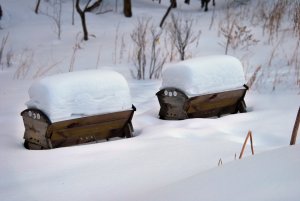- All-In-One Beekeeping for the Bees
- +1-608-728-8233
- info@beepods.com
Protect Your Bees from Winter Winds and Precipitation With These Tips


You know the feeling: You’re bundled up outside, breathing in the cold winter air and admiring the snowflakes that are gently falling around you. Then, BOOM. You’re hit with a gust of wind. Suddenly it feels like the temperature dropped 20 degrees, and those gentle snowflakes are now pelting your cheeks like tiny daggers. Winter winds and precipitation have arrived
You’re not the only one who might not enjoy the onslaught of cold and wet conditions. Your bees’ comfort and survival this winter depends heavily on your understanding of how winds and precipitation will affect their hive. Today, we’re exploring the impacts of winter winds and precipitation on your colony and how you can help your bees withstand winter weather.
The Dangers of Winter Winds
As icy winter temperatures become the norm in many northern regions, your bees are taking steps to stay warm and safe. Once cold weather sets in (50-57℉ or lower), bees will form their winter cluster. The bees huddle to form a close mass around their queen as temperatures drop, and move throughout the hive as needed to access honey stores.
When winter winds find their way into a hive, it can create a devastating deadout scenario for your bees. Periods of prolonged exposure to the wind can drop hive temperatures very drastically. Your bees’ efforts to warm themselves and their queen will be thwarted. Colonies can die within a matter of hours when, despite their best attempts to heat the cluster, cold air bursts into their space.
Beekeepers can help their bees avoid this scary scene by preparing your hive for the winter. Top bar hives like Beepods benefit from the Beepods BeeRito Wrap included in our Beepods System Winterizing Kit. The BeeRito Wrap keeps harsh winds out of the hive so your bees can cluster safely and stay warm.
Impacts of Winter Precipitation
Access for Cleansing Flights

Winter precipitation build-up can make it difficult for bees to leave the hive.
Snow and other winter precipitation can present a variety of challenges for your bees. The snow, sleet, and ice that blankets your property can also accumulate on and around your hives. Built-up ice and snow can create a physical block to your bees’ flight path and make it difficult for them to leave/enter the hive on warmer days.
Cleansing flights are the trips your bees will take out of the hive when it’s at least 40℉ outside. They do this to, for lack of a better term, poop. If ice or snow blocks their hive entrances, the bees can’t get out to do their buzz-ness. Beekeepers should monitor their hives to ensure their bees can get in and out as needed.
Winter Precipitation and Moisture
If winter precipitation gets into your hive, it’s very dangerous for your bees. Excess moisture in the hive creates a breeding ground for fungus and mold that can take over comb cells and create a mess for beekeepers. Pair that moisture with the heat your clustering bees generate, and you have a recipe for disaster and dead bees.
Ventilating your hive is the best way to ensure that winter precipitation won’t lead to a moist and lethal mess inside. Beepods’ Winterizing System Kit includes an insulating desiccant that absorbs moisture while allowing for ventilation inside the hive. And, if you notice the beginnings of excess moisture in your hive, you can adjust your vents to encourage evaporation.
Conclusion
Winter winds and precipitation can have dangerous impacts on your hives. Still, with proper planning, you can protect your bees from these seasonal weather conditions. Take steps to winterize your hive and prepare your bees for the cold, and they’ll thrive and survive this winter.
Kanoe Riedel
Latest posts by Kanoe Riedel (see all)
- This Spring, Don’t Forget Why Bees Are So Important to Our Environment - March 26, 2021
- 11 Awesome Uses for Your Stored Honeycomb - March 2, 2021
- How the Right Beekeeping Equipment Makes Inspections Better for Beekeepers and Bees - February 12, 2021



